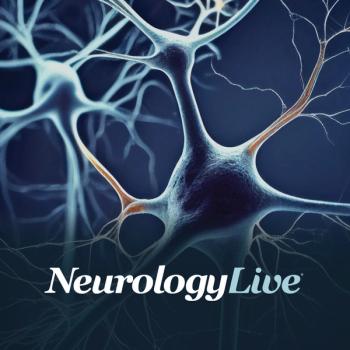
CNM-Au8 Shows Positive Findings on MS-Related Biomarkers of Whole Brain, White Matter
On diffusion tremor imaging, CMN-Au8 outperformed placebo on domains of fractional anisotropy, radial diffusivity, and mean diffusivity, across all 9 prespecified brain regions and brain white matter.
Newly announced findings from the phase 2 VISIONARY-MS study (NCT03536559) assessing Clene Nanomedicine’s investigational agent CNM-Au8 in patients with relapsing multiple sclerosis (MS) showed that the agent significantly impacted brain neuronal structural integrity, demonstrated by changes in axonal integrity and white matter integrity.1
Over a 48-week period, investigators observed a least square mean difference in fractional anisotropy change within the whole brain of 0.0029 (95% CI, 0.0048 to 0.0054; P = .0199) and fractional anisotropy change within total cerebral white matter of 0.0026 (95% CI, –0.0003 to 0.0055; P = .0805). Additionally, at the same time point, there was a 0.0025 (95% CI, –0.00025 to 0.0053; P = .0737) least-square mean difference in change within total cerebral normal appearing white matter.
"The totality of the clinical and paraclinical data from the VISIONARY-MS trial are robust,” trial investigator Benjamin Greenberg, MD, MHS, FANA, FAAN, CRND, professor and Cain Denius Scholar in Mobility Disorders, Department of Neurology, and Department of Pediatrics, UT Southwestern Medical Center, said in a statement.1 "These latest MRI results strongly reinforce the previously reported findings of global clinical neurological improvement. There is a critical unmet need in multiple sclerosis therapeutics for interventions that protect neuronal function and myelin health independent of immunomodulation or suppression. Years have been spent seeking a truly neuroprotective therapy for multiple sclerosis and other neurodegenerative diseases. These data argue in favor of pursuing CNM-Au8 in further Phase 3 studies."
Each of these findings, observed through diffusion tensor imaging, highlight improvements in domains of fractional anisotropy, radial diffusivity, and mean diffusivity across all 9 prespecified brain regions and brain white matter tracts for each metric. While additional lesion MR analyses are currently underway, CMN-Au8 continued to show favorable results over placebo in MRI measures of myelin integrity, including magnetization transfer ratio and myelin water fraction.
"Importantly, these data further reinforce our hypothesis that improving brain energetic metabolism results in improved neurological structure and function when CNM-Au8 is administered as adjunct to standard immunomodulatory disease-modifying MS therapies,” Robert Glanzman, MD, FAAN, chief medical officer, Clene Nanomedicine, said in a statement.1 "Clene plans to initiate a fully powered Phase 3 study to demonstrate improved global neurological function in patients with progression independent of relapse activity (PIRA), the most urgent unmet need in MS today, in collaboration with a development partner. We look forward to presenting these MRI data at the upcoming forum for Americas Committee for Treatment and Research in Multiple Sclerosis (ACTRIMS) taking place February 22-25, 2023.”
READ MORE:
CNM-Au8, an oral suspension of gold nanocrystals,
The study featured patients with stable MS with a history of chronic visual impairment (who are allowed disease-modifying therapy) in a 1:1:1 fashion to CNM-Au8 in doses of 15 mg/day or 30 mg/day, or placebo. Its execution was halted because of operational challenges related to COVID-19, enrolling 73 of 150 anticipated participants, thus the threshold for significance was set at P = .10 prior to database lock.
Additional secondary outcomes originally reported included the LS mean difference in mMSFC average rank score (LS mean difference, 13.38; 95% CI, 2.83-23.94; P = .0138) and the time to first repeated clinical improvement to Week 48 (treatment: 45%; placebo: 29%; P = .3991). As well, CNM-Au8 showed favorable signs of consistent improvement across a variety of paraclinical biomarkers— multifocal visual evoked potentials (mfVEP) amplitude and latency, and optical coherence tomography—and MRI end points—magnetization transfer ratio and diffusion tensor imaging metrics.
REFERENCES
1. Clene reports new data from the VISIONARY-MS phase 2 study in multiple sclerosis demonstrating CNM-Au8 treatment improved brain neuronal structural integrity. News release. February 13, 2023. Accessed February 13, 2023. https://www.globenewswire.com/news-release/2023/02/13/2606498/0/en/Clene-Reports-New-Data-from-the-VISIONARY-MS-Phase-2-Study-in-Multiple-Sclerosis-Demonstrating-CNM-Au8-Treatment-Improved-Brain-Neuronal-Structural-Integrity.html
2. Clene Reports Positive Topline Results for CNM-Au8® in the Phase 2 VISIONARY-MS Trial in Multiple Sclerosis. News release. Clene Nanomedicine. August 15, 2022. Accessed February 13, 2023. https://www.globenewswire.com/news-release/2022/08/15/2498070/0/en/Clene-Reports-Positive-Topline-Results-for-CNM-Au8-in-the-Phase-2-VISIONARY-MS-Trial-in-Multiple-Sclerosis.html
Newsletter
Keep your finger on the pulse of neurology—subscribe to NeurologyLive for expert interviews, new data, and breakthrough treatment updates.


































